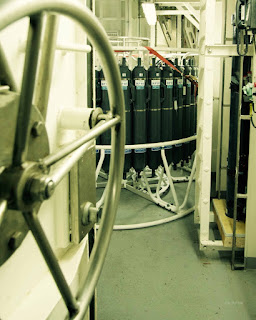I'm back in the Indian Ocean's waters, after 2 years, and at sea again just after 4 months from my last cruise. My most recent expedition was in the Pacific Ocean as part of the US-GOSHIP repeat hydrography (you'll find the blog for that expedition at usgoship-p062017.blogspot.com)... not bad for a modeler! ;-)
It's quite exciting for me, to be in these waters again. This time, I'm part of the X Indian Southern Ocean Expedition organized by the National Centre for Antarctic and Ocean Research, from Goa (India). Our track will bring us to the western side of the Kerguelen Plateau, a massive topographic barrier to the eastward flowing Antarctic Circumpolar Current, and then down to Antarctica. I have a special love for this area, as it has been the focus of my PhD thesis (see previous blog posts).
I left San Diego on November 30th. Leaving home, especially saying goodbye to my husband Diego, is never easy. But both my friends and Diego always give me courage and support me no matter what, which makes the departure a little bit less painful. Armed with my big luggage, my guitar and a backpack with my camera and computer, I started my journey to the far Mauritius. I had a veeeery long flight and reached Mauritius about 30 hours and 3 flights later. The island is gorgeous, and people are just incredibly kind, smiling and helpful, and I had a wonderful day and half to recover from the long flight and prepare the last things before departure.
We were planned to leave on December 7th, but we had several issues, first a delay with the delivery of the floats and gear, and then some technical problems at the ship, the R/V Agulhas I. We finally left port on December 9th, 2017, at 12:00PM UTC. We had to go back to port for a medical evacuation just few hours later, but we are steaming now at full speed towards our first station, which is planned for December 14th, 3 days from now.
The vessel is the first South African icebreaker, now used for training and some scientific expeditions, such as this one. There are 20 cadets onboard, and other 40 people between officers and ship crew. From the science party there are 41 scientists from several Indian Institutes, plus me from Scripps. Science activities cover both physical and biogeochemical oceanography, and atmospheric science. The expedition will be documented by Rakesh Roa, an excellent Scientific Documentary filmographer and photographer, former Physicist with a strong background in Astronomy. Yesterday night he gave Zoelle the doctor onboard and me an amazing 2-hour "lesson" of the sky, with its constellations, and stars, and identified Andromeda Galaxy, Large and Small Magellanic Clouds (which are other 2 galaxies). I can't wait to know more!!
My main duties onboard are deploying 7 biogeochemical profiling floats and collect water samples which I'll send back to the US to be analysed for nutrients, pH/Alkalinity and HPLC/POC. The floats are from the Southern Ocean Carbon and Climate Observations and Modeling project (SOCCOM, https://soccom.princeton.edu/), and have all been adopted and named by different classes from Middle and High Schools in the US, as part of the "Adopt-A-Float" program. Stay tuned to know more about these floats.. and see pictures!!
Unfortunately, we don't have much internet capability, and we are all sharing 2 computers for sending emails. Internet is also super slow, and it takes me about 20 minutes to log into the email webpage.. So, I'm not sure how much I'll be able to update the blog during the cruise, especially I'm not sure if I'll be able to upload some photos. I'll give it a try with this blog post and see how it goes :)
All for now.. Stay warm and enjoy these last days of 2017! :)




























